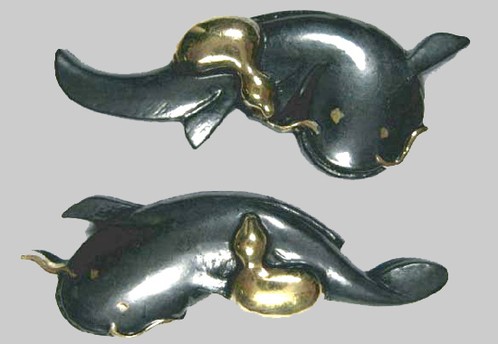

More informations about this product
Menuki with catfish and a calabash gourd - Namazu Ni Hyotan (鯰に瓢箪).
Menuki Omote: Length 35.5mm, Width 14.5mm, Height 4.5mm
Menuki Ura: 36mm length, 13mm width, 4.5mm height
The Namazu, catfish, is in Japanese symbolism at the origin of earthquakes throughout Japan.
It is attributed this ability because catfish sometimes move in the hours preceding earthquakes.
In Japanese legends, it is nicknamed O-Namazu 大鯰.
Although the O-Namazu is held responsible for catastrophic earthquakes, it is also hailed as 'Yo-Naoshi Daimyōjin', the god "rectifier of the world".
Thus causing disorder, it regulates the human world by destabilizing the wealthy classes and redistributing wealth.
It is a sort of "avenger of social injustice", highly respected by the poor classes and feared by the rich and powerful.
It is a symbol of opportunity, renewal, good fortune and prosperity.
The Hyotan, once hollowed out and dried, was used as a gourd for water, sake, seeds, and sometimes even as a vase for flowers.
It is a symbol of good luck, protection, and good health.
More generally in Japanese culture, the Hyotan is a talisman against evil spirits, and brings luck and prosperity to its owner.
The symbol of the catfish and the Hyotan gourd dates back to the time of Shogun Ashikaga Yoshimichi (1394-1423).
This Shogun stated the riddle: "Is it possible to catch a slippery catfish with a calabash?"
The complexity and the number of possible answers illustrate the impossibility of understanding Zen through rational logic.
It is also the idiom used to describe elusive and elusive things. It is therefore a question of carrying out a task that appears impossible and succeeding anyway.
Share your opinion
error Your review appreciation cannot be sent
feedback Report comment
check_circle Report sent
error Your report cannot be sent